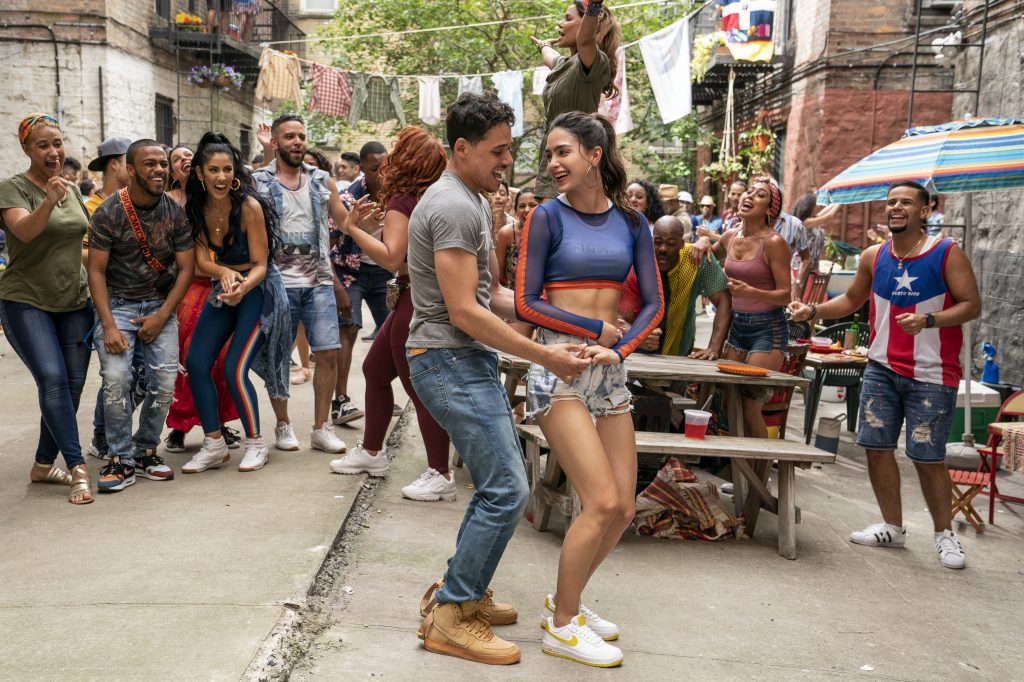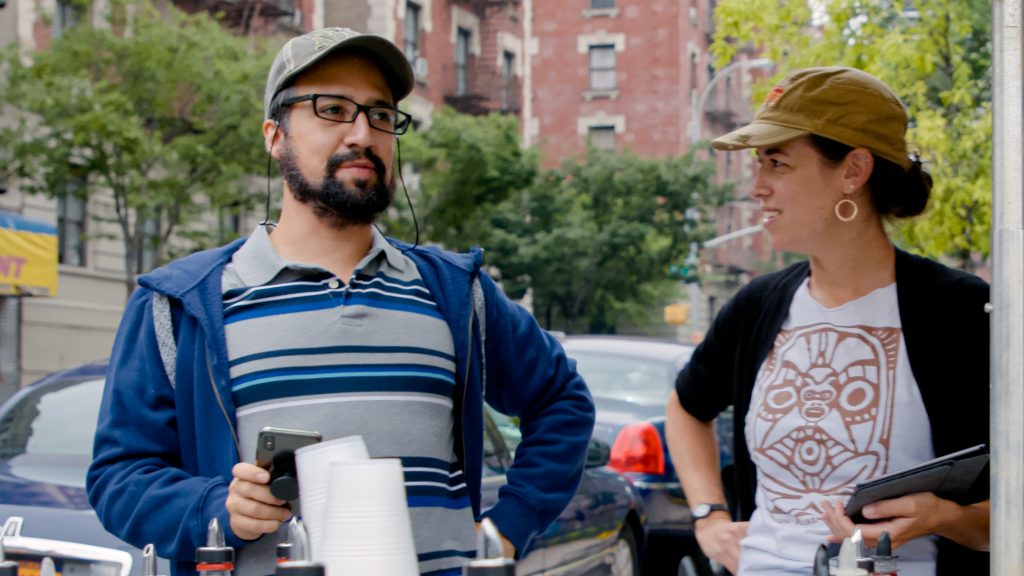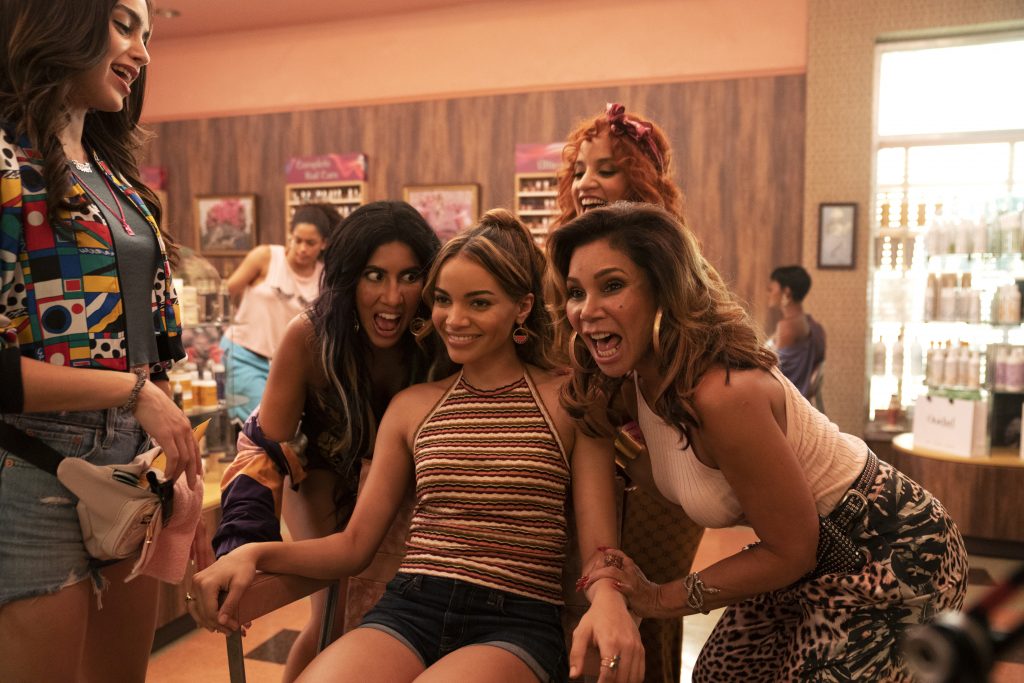
Anthony Ramos as Usnavi and Mellissa Barrera as Vanessa in “In the Heights.” (Warner Bros./Macall Polay)
“In the Heights” is a film of contradictions. It is an ode to Washington Heights, the Manhattan neighborhood above 155th street, yet its characters struggle with the desire to break free from their home. It is both a celebration of the unique Hispanic culture that has flourished in the Heights, and a stark reminder that this community and those like it are at risk of annihilation.
The film, which premieres June 11 in theatres and on HBO Max, plays like a tapestry of a neighborhood in crisis. Each individual storyline delivers a new perspective on the issues and internal struggles that residents of the Heights, and the immigrant community at large, face on a daily basis. It primarily follows Usnavi (Anthony Ramos), a young man who operates a bodega in the Heights with his younger cousin Sonny (Gregory Diaz IV). “In the Heights” is based on the Broadway musical of the same name by Lin Manuel Miranda and Quiara Alegría Hudes. In a roundtable interview with the Wheel, Miranda spoke about growing up in the Heights and how scenes from his childhood helped to inspire the character of Nina (Leslie Grace), who is torn between her studies at Stanford University (Calif.) and the responsibility she feels towards her home and her family. “[Hudes and I] both pulled from our personal histories. I do think Nina is the closest bone for me in terms of my lived experience. I remember my mom and dad both taking on jobs when my sister went off to school. I remember seeing my mother burst into tears at the table.”

Lin-Manuel Miranda and Quiara Alegría Hudes on the set of “In the Heights.” (Warner Bros.)
Director Jon M. Chu, in collaboration with Miranda and Hudes, crafts a vision of Washington Heights that is staggering in its attention to detail. He turns the Heights into a mythical place, the asphalt and brownstones are drenched in the sweltering heat of the midsummer New York City sun. The otherworldliness of Chu’s Washington Heights is amplified by moments of surrealism. The final song between Benny (Corey Hawkins) and Nina takes place on a building that is slowly turning to allow the couple to dance up the wall, with the George Washington Bridge at a 90-degree angle behind them.
Olga Merediz, who plays the role of Usnavi’s Abuela, Claudia, described the first time she saw her character’s song, “Paciencia y Fe,” realized in Chu’s startlingly dreamlike vision. “The way Chu portrayed it, it was almost like he was Cuban … the choreography of Cuba past … her everyday life on the New York City subway. … It was just a miracle the way he shot that and portrayed it. For me it was overwhelming.”
Beyond visual style, the soul of “In the Heights” is the neighborhood itself. It is crafted with such meticulous detail, achieved not only through the script, but with the cast’s firsthand knowledge of their own community. Dascha Polanco plays Cuca, one of the women who work at the salon, trading gossip and offering advice to those in need. In her roundtable interview with the Wheel, Polanco said “It’s part of our culture to have intimate moments with your salon lady. It’s a therapy session, one of the pillars in our community. It’s a safe place for us to feel at home.” She also mentioned drawing inspiration from the women who raised her. “The familiarity of getting to draw inspiration from a family member, or someone you know, is quite entertaining for us and enriching as an actor. It definitely gives us a sense of ‘this is where we can let loose … and feel proud.’”

Melissa Barrera as Vanessa, Stephanie Beatriz as Carla, Leslie Grace as Nina Rosario, Dascha Polanco as Cuca and Daphne Rubin-Vega as Daniela in “In the Heights.” (Warner Bros./Macall Polay)
“In the Heights” excels at crafting a gorgeous and loving depiction of Washington Heights. Where it falters is in its message. The story primarily focuses on gentrification of majority-minority neighborhoods and the injustice of the American immigration system. While the film correctly identifies many of the problems facing marginalized communities in the United States, it fails to present any sort of viable solution. The characters either accept the injustices piled on top of them or seek to alleviate injustice by working from within an unjust system. For example, Nina feels she must sacrifice herself to the traditionally white supremacist institution of academia to hopefully make life better for those back home. Spike Lee’s 1989 masterpiece “Do the Right Thing” had a similar vision of portraying a neighborhood, crafted with minute detail, as a microcosm for the struggles of oppressed people in the United States. Yet Lee’s characters don’t get a winning lottery ticket that promises freedom from injustice. Rather, they are forced to take action against the oppressor. “In the Heights” can sometimes feel like a Disney-fied version of Lee’s story, with a naive belief that oppressive systems can fix themselves.
Despite “In the Heights” struggling with watered-down political messages, the heart of the film is a jubilant celebration of a culture on the brink of destruction and a powerful love story between a community and the place they call home. It is a dazzling reintroduction to the movie theater after more than a year without them. The amount of care that Chu, Miranda and Hudes have taken in recreating Washington Heights is incredible, and the film is worth seeing for this alone. Although the film premieres on June 11 both in theatres and on HBO Max, it is truly an experience one should have on the big screen. After a long, difficult year, “In the Heights” feels like a catharsis, and there’s music in the street once more.
"dazzling" - Google News
June 08, 2021 at 03:03AM
https://ift.tt/3fX95rI
'In the Heights' is a Dazzling Return to the Cinema - The Emory Wheel
"dazzling" - Google News
https://ift.tt/2SitLND
Shoes Man Tutorial
Pos News Update
Meme Update
Korean Entertainment News
Japan News Update
Bagikan Berita Ini
















0 Response to "'In the Heights' is a Dazzling Return to the Cinema - The Emory Wheel"
Post a Comment